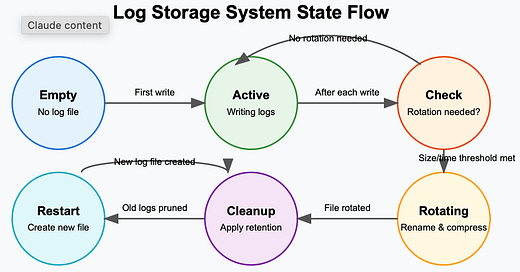Welcome to Day 5 of our journey into distributed systems! Today, we're going to build something that forms the backbone of many production systems: a log storage mechanism with rotation capabilities. This seemingly simple component plays a crucial role in system reliability, debugging, and data analysis.
Why Log Storage Matters in Distributed Systems
Imagine you're running a restaurant with 20 chefs working simultaneously. If they all shouted their activities without recording them, you'd have chaos! Similarly, in distributed systems, components across multiple servers generate information constantly. Without proper storage and organization of these logs, troubleshooting becomes nearly impossible.
Real-world examples you might recognize:
Netflix uses sophisticated log management to monitor their streaming services across thousands of servers
Online games track player actions to detect cheating and improve gameplay
Banking apps record every transaction for security and compliance
Understanding Log Rotation
Think of log rotation like changing notebooks when one gets full. Without rotation:
Files grow endlessly, consuming disk space
Searching through massive log files becomes painfully slow
System performance degrades
You risk completely filling storage and crashing your application
Log rotation allows us to:
Cap file sizes
Organize logs by time periods
Automatically delete old logs
Compress older logs to save space
Where Log Storage Fits in System Design
In our distributed log processing system, the log storage component sits between log collection and log analysis. It acts as the persistent layer that ensures we don't lose valuable information even if processing components fail.
Today's component will later connect with:
The log parser we built yesterday
Future components like indexing and search
Analytics and visualization tools we'll build later
Building Our Log Storage System
Let's create a Python-based log storage system with rotation policies. Our system will:
Write logs to flat files
Rotate based on file size or time elapsed
Support basic compression of rotated logs
Maintain a configurable retention policy






